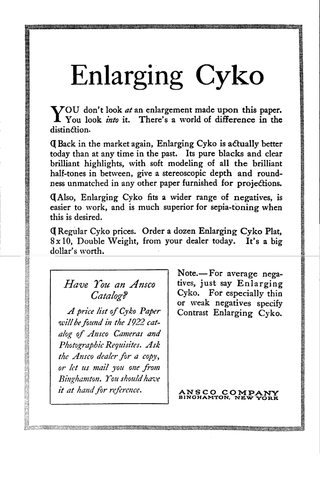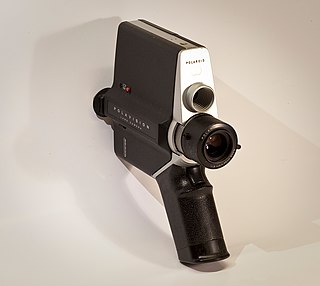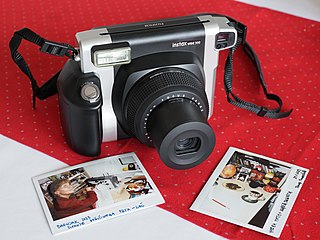
Polaroid art is a type of alternative photography which consists of modifying an instant picture, usually while it is being developed. The most common types of Polaroid art are the emulsion lift, the Polaroid transfer and emulsion manipulation.

Polaroid art is a type of alternative photography which consists of modifying an instant picture, usually while it is being developed. The most common types of Polaroid art are the emulsion lift, the Polaroid transfer and emulsion manipulation.
An emulsion lift, or emulsion transfer, is a process used to remove the photographic emulsion from an instant print. The emulsion can then be transferred to another material, such as glass, wood or paper. [1] The emulsion lift technique can be performed on peel-apart film and Polaroid Originals integral film, but not on Fujifilm Instax film. The procedure, for integral type film, involves cutting off the picture's border, separating the negative layer from the positive layer and submerging the positive layer in warm water. The emulsion will start to come free from the plastic layer and float on the water. While it is still wet, it can be placed on another material and shaped. It can be laid flat, or it can be folded, ripped or otherwise customized as desired.
When done with Fujifilm FP-100C, the picture is placed in water near the boiling point and then submerged in cold water. [2] This will release the emulsion, which resembles cellophane and is harder to manipulate than Polaroid emulsions. [3]
A Polaroid transfer, sometimes known as an image transfer, is a technique used to develop a peel-apart film picture on to a different material, like drawing paper. In a Polaroid transfer, the image is peeled apart prematurely and the negative is placed down on a desired material. A roller is sometimes used to ensure the negative is laying down flat on the material. After a certain amount of time, the negative is peeled back. [4]
Emulsion manipulation is used to modify integral film pictures while they are developing. The technique yields the best results with the original SX-70 Time Zero film, which was discontinued in 2005, and the currently manufactured Polaroid Originals film is less manipulable. As the picture develops, modifications can performed by applying pressure on the surface of the film, using tools that do not scratch the outer plastic layer. Alternatively a pattern can be superimposed on the image by laying the film face-down on a textured surface and applying pressure. As development finishes the emulsion hardens, but to continue the manipulation it can be softened by warming it up. [5] [6] The technique was used to make the cover of Peter Gabriel's third self-titled album. [7]
| Alternative photography |
|---|
 |

Film stock is an analog medium that is used for recording motion pictures or animation. It is recorded on by a movie camera, developed, edited, and projected onto a screen using a movie projector. It is a strip or sheet of transparent plastic film base coated on one side with a gelatin emulsion containing microscopically small light-sensitive silver halide crystals. The sizes and other characteristics of the crystals determine the sensitivity, contrast and resolution of the film. The emulsion will gradually darken if left exposed to light, but the process is too slow and incomplete to be of any practical use. Instead, a very short exposure to the image formed by a camera lens is used to produce only a very slight chemical change, proportional to the amount of light absorbed by each crystal. This creates an invisible latent image in the emulsion, which can be chemically developed into a visible photograph. In addition to visible light, all films are sensitive to X-rays and high-energy particles. Most are at least slightly sensitive to invisible ultraviolet (UV) light. Some special-purpose films are sensitive into the infrared (IR) region of the spectrum.

Polaroid Corporation was an American company best known for its instant film and cameras, which now survives as a brand for consumer electronics. The company was founded in 1937 by Edwin H. Land, to exploit the use of his Polaroid polarizing polymer. Land and Polaroid created the first instant camera, the Land Camera, in 1948.

The Land Camera is a model of self-developing film camera manufactured by Polaroid between 1948 and 1983. It is named after the inventor, American scientist Edwin Land, who developed a process for self-developing photography between 1943 and 1947. After Edwin Land's retirement from Polaroid in 1982, the name 'Land' was dropped from the camera name. The first commercially available model was the Model 95, which produced sepia-colored prints in about 1 minute. It was first sold to the public on November 26, 1948.
Photographic processing or photographic development is the chemical means by which photographic film or paper is treated after photographic exposure to produce a negative or positive image. Photographic processing transforms the latent image into a visible image, makes this permanent and renders it insensitive to light.

Photographic paper is a paper coated with a light-sensitive chemical formula, like photographic film, used for making photographic prints. When photographic paper is exposed to light, it captures a latent image that is then developed to form a visible image; with most papers the image density from exposure can be sufficient to not require further development, aside from fixing and clearing, though latent exposure is also usually present. The light-sensitive layer of the paper is called the emulsion. The most common chemistry was based on silver halide but other alternatives have also been used.

Fujifilm Holdings Corporation, trading as Fujifilm, or simply Fuji, is a Japanese multinational conglomerate headquartered in Tokyo, Japan, operating in the realms of photography, optics, office and medical electronics, biotechnology, and chemicals.

An instant camera is a camera which uses self-developing film to create a chemically developed print shortly after taking the picture. Polaroid Corporation pioneered consumer-friendly instant cameras and film, and were followed by various other manufacturers.

Instant film is a type of photographic film that was introduced by Polaroid Corporation to produce a visible image within minutes or seconds of the photograph's exposure. The film contains the chemicals needed for developing and fixing the photograph, and the camera exposes and initiates the developing process after a photo has been taken.

The SX-70 is a folding single lens reflex Land camera which was produced by the Polaroid Corporation from 1972 to 1981. The SX-70 helped popularize instant photography.
A film holder is a accessory that holds one or more pieces of photographic film, for insertion into a camera or optical scanning device such as a dedicated film scanner or a flatbed scanner with film scanning capabilities. The widest use of the term refers to a device that holds sheet film for use in large format cameras, but it can also refer to various interchangeable devices in medium format or even 135 film camera systems.
Polaroid Type 55 film is a black-and-white peel-apart Polaroid film that yields both a positive print and a negative image that can be used to create enlargements.

Analog photography, also known as film photography, is a term usually applied to photography that uses chemical processes to capture an image, typically on paper, film or a hard plate. These processes were the only methods available to photographers for more than a century prior to the invention of digital photography, which uses electronic sensors to record images to digital media. Analog electronic photography was sometimes used in the late 20th century but soon died out.

Polavision was an "instant" color home movie system launched by Polaroid in 1977.

Instax is a brand of instant still cameras and instant films marketed by Fujifilm.
Fujicolor Pro was a line of professional color negative films from Japanese company Fujifilm introduced in 2004 for weddings, portraits, fashion and commercial photography. It originally comprised four emulsions: Pro 160S, Pro 160C, Pro 400H and Pro 800Z. Its main competitor was Kodak Portra.

Photographic film is a strip or sheet of transparent film base coated on one side with a gelatin emulsion containing microscopically small light-sensitive silver halide crystals. The sizes and other characteristics of the crystals determine the sensitivity, contrast, and resolution of the film. Film is typically segmented in frames, that give rise to separate photographs.

Polaroid B.V. is a Dutch photography and consumer electronics company, founded as a manufacturer of discontinued film for Polaroid Corporation instant cameras. The company produces new instant cameras under the Polaroid brand name as well as wireless speakers and other accessories.